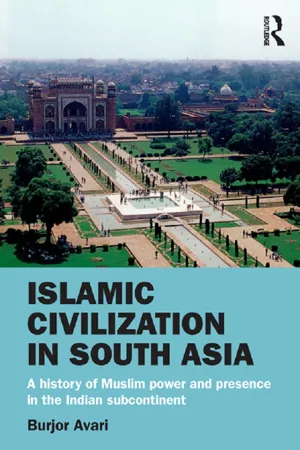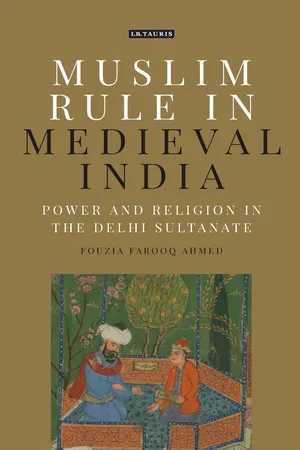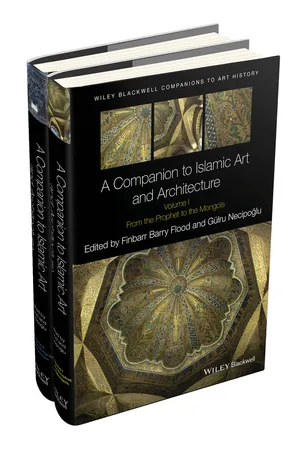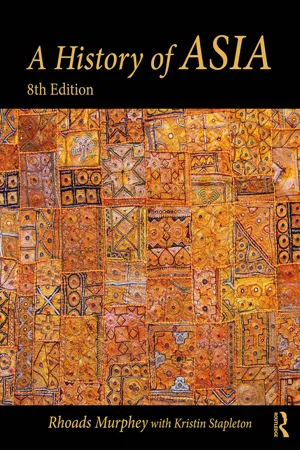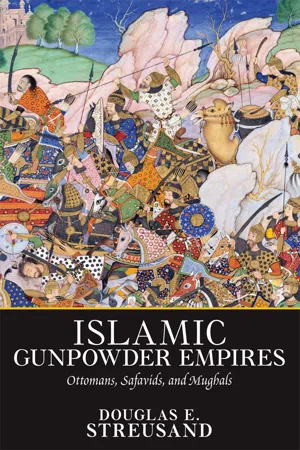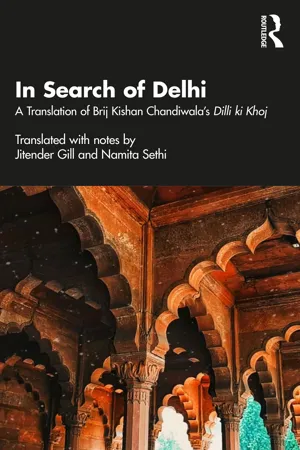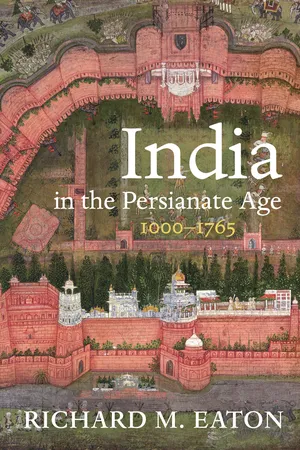History
Delhi Sultanate
The Delhi Sultanate refers to the Muslim kingdom that ruled over parts of the Indian subcontinent from the 13th to the 16th century. It was established after the conquest of Delhi by various Turkic and Afghan dynasties. The Delhi Sultanate played a significant role in shaping the political, cultural, and architectural landscape of the region during this period.
Written by Perlego with AI-assistance
Related key terms
9 Key excerpts on "Delhi Sultanate"
- eBook - ePub
Islamic Civilization in South Asia
A History of Muslim Power and Presence in the Indian Subcontinent
- Burjor Avari(Author)
- 2012(Publication Date)
- Routledge(Publisher)
4 The Delhi Sultanate at its Zenith (1206–1351)The Ghurid conquests between 1186 and 1206 eventually led to the establishment of what is called the Delhi Sultanate. This was essentially a regional North Indian power, although during its zenith its territorial boundaries extended southwards too. The fact that it was regional should not mislead us into thinking that other Indian states in the thirteenth and fourteenth centuries had the capacity to challenge its might. The sultanate lasted from 1206 until the advent of the Mughals in 1526, but from 1351 onwards its power markedly declined.Before 1206, apart from Sind, Muslim authority in India was confined to Punjab and the frontier lands between present day Afghanistan and Pakistan. The Ghaznavids and Ghurids were dynasties essentially shaped and influenced by the political conditions of the eastern Iranian, Transoxanian and Afghan regions. While the Turkish and Persian influences that they had brought into India continued after 1206, from then on the sultanate matured and developed essentially within the Indian heartland; and Indian cultural influences succeeded in making it an Indian polity, distinct from the Iranian or Central Asian. It was simultaneously a Muslim authority and, in that respect, it was alien to the vast majority of Hindu Indians. Over time, how ever, the sultans of Delhi charted out a balanced strategy of survival and domination in an alien religio-political landscape, which helps explain the relative longevity of the system they established.Sultans and NoblesThe sultanate was an authoritarian monarchy: there was no question of democratic politics. On the other hand, the possession of the throne did not entitle a sultan to rule with unchecked powers. Although wielding great authority and sizeable patrimony, each sultan had to be conscious of the sensibility of military and religious grandees around him. Whenever a sultan trampled on that sensibility, his fate was sealed, which happened more often than not. - eBook - ePub
India
The Definitive History
- D. R. SarDesai(Author)
- 2018(Publication Date)
- Routledge(Publisher)
The period of the so-called Sultanate of Delhi extended from 1208 when Muslim rule was, for the first time, established in Delhi to the beginning of the Mughal rule in 1526. Except for some thirty years when the writ of the Sultanate of Delhi extended over almost all of the subcontinent, including South India, the territories under the sultanate were limited. In the period 1208–1526, there were at least a half-dozen sultanates in the country having their own territorial jurisdiction, most often independent of Delhi.The two short periods during which the Sultanate of Delhi exercised authority over most of the subcontinent were the regimes of Ala-uddin Khalji (1296– 1316) and the early Tughluqs (1320– 1351). Besides the Sultanate of Delhi, there were seven other sultanates: the Gujarat (1407–1526), Khandesh (1370– 1510), Malwa (two dynasties) (1401– 1531), Jaunpur (1394–1479), Bengal (four dynasties) (1282–1533), Multan (1444–1525), and the Bahmani Sultanate of the Deccan (1347–1482). Moreover, there were several Hindu kingdoms. Vijayanagar (1336–1565), Mewar (1314–1528), Marwar, Mithila, Orissa, and Assam were not subjugated throughout the period of the so-called sultanate, nor were the Hindu kingdoms of the deep south brought under Muslim rule except briefly during the Khalji rule.The Sultanate of Delhi was held by five separate dynasties: the Slave Dynasty (1208–1290), the Khaljis (1290– 1320), the Tughluqs (1320–1414), the Sayyids (1414–1451), and the Lodis (1451–1526). Thirty-four sultans sat on the Delhi throne during a little more than three centuries. In all the cases of transition from one dynasty to another, there was violence, bloodshed, and instability. The same was true for a majority of the ordinary successions from one ruler to the other within the same family or dynasty. The primary reason for the lack of peaceful transfers of power was the lack of laws governing succession in a Muslim state, making it susceptible to palace intrigue and individual ambition on the part of sons or close relatives within the ruling family. Consequently, the period of the Sultanate of Delhi was riddled with shifting loyalties, political groupings whose sole binding factor was individual self-interest and little, if any, concern for the ordinary subjects. - eBook - ePub
Muslim Rule in Medieval India
Power and Religion in the Delhi Sultanate
- Fouzia Farooq Ahmed(Author)
- 2016(Publication Date)
- I.B. Tauris(Publisher)
INTRODUCTION The Delhi Sultanate was established as a corollary of military expeditions by the Ghaznawids (352–582/962–1186) and Ghūrīds (558–602/1163–1206) that extended the eastern Islamic frontiers into Gangetic plains. The successful rulers of both these dynasties carved out principalities in northern India and established garrison towns and colonies, many of which later became the political and military strongholds of their legatees; the Delhi sultans. This work offers insight into regime formation, regime perpetuation and regime disintegration of Muslim states within Indian settings. It also provides additional understanding of the policies of sultans and their ruling class that formed a religious, racial and linguistic minority whose religious and cultural symbols and rituals captured an attempt at moral validation of their power. In the process, this book describes the political dynamics of medieval Muslim states in non-Muslim societies. The Delhi Sultanate is generally perceived as an exceptionally centralised political structure; nevertheless there was a visible asymmetrical distribution of power on the geographical level, making it a segmentary state, 1 comprised of a cluster of military strongholds and taxed agrarian hinterlands. The Delhi sultans ruled territories of northern India from a core region of control in Delhi and its adjacent territories, which gradually expanded – yet the borders of the sultanate fluctuated frequently. Under stronger rulers the sultanate expanded. These annexations, following this expansion policy, occasionally brought some areas of south India under direct control and reduced others to the status of tributaries. The affiliation of the eastern provinces, including Bengal, also hinged upon the strength of the rulers. The weaker rulers were unable to command and control, leaving these territories to either rebellious governors or unruly local elements - eBook - ePub
- Finbarr Barry Flood, Gulru Necipoglu, Dana Arnold, Finbarr Barry Flood, Gulru Necipoglu(Authors)
- 2017(Publication Date)
- Wiley-Blackwell(Publisher)
The phenomenon of colonization is so firmly associated with European domination of Asia, Africa, and the Americas that it is easy to overlook its pre‐modern history within non‐western societies. States like the Delhi Sultanate were not only imperial in the sense that they were multiethnic polities ruling over diverse regions, but they also depended on colonies of settlers from the metropole as a means of establishing political control in conquered territories. We will here refer to this process as colonization, reserving the term “colonialism” for the specifically modern European form.The Delhi Sultanate’s colonization of the Deccan began with a series of ambitious campaigns that demonstrated Delhi’s military superiority and resulted in the collapse of the three Indic polities that had previously dominated the region – the kingdoms of the Yadavas (1187–1318), the Kakatiyas (1163–1323), and the Hoysalas (1192–1342). In the immediate aftermath of these conquests outside settlement of the region was limited, and concerted attempts were made to incorporate defeated local rulers and their subordinates as loyal vassals of Delhi. When this strategy proved unsuccessful, Delhi brought the region under direct rule, settling larger numbers of military and administrative personnel and charging them with the task of imposing north India’s Persianate and Islamic political culture upon the region. For a brief period in the 1320s, attempts were even made to transfer the entire population of Delhi to Daulatabad, in response to the southward shift of the sultanate’s center of gravity. The forced exodus was disruptive and unpopular among Delhi’s citizens, and most eventually returned to Delhi. But this wholesale migration of a broad cross‐section of Delhi’s population – including not only members of the ruling elite and administrative bureaucrats but also religious figures, merchants, and craftspeople – had a profound effect on the subsequent development of Deccani politics, culture, and art. - eBook - ePub
- Rhoads Murphey, Kristin Stapleton(Authors)
- 2019(Publication Date)
- Routledge(Publisher)
Source: Alberuni’s India: An Account of the Religion, Philosophy, Literature, Geography, Chronology, Astronomy, Customs, Laws and Astrology of India about A.D. 1030 , Volume 1, K. Paul, Trench, Trubner & Co. Ltd., 1910; Based on a poem of a Rajput lady from H. G. Rawlinson, India: A Short Cultural History (New York: Praeger, 1965), p. 228.The armies of the Delhi Sultanate, like those of the Ottomans and other Turkish states, owed their strength in large part to mamluks , usually Turks bought in their youth as slaves and then trained as full-time professional fighters. They were an outstandingly disciplined force, but like many lifetime mercenaries they were not above an interest in power and in its rewards. Military commanders at the head of mamluk troops could be formidable political contenders. The ruthlessness and often extreme cruelty of many of the sultans provided frequent motives for revolt. Many of the rulers of Delhi began their careers as mamluk fighters, and so the regime is also known as the “slave dynasty.”In general, the sultanate succeeded only partially and for brief periods in becoming an effective administration for the areas it controlled in the north. The records we have tell us about power rivalries, intrigues at court, tax policies, coups, civil wars, and the abortive efforts to invade the south, but we have little concrete evidence of how much these petty affairs of state affected the lives of most ordinary people. Political power was highly concentrated in Delhi, leaving much of the sultanate’s domains under local rulers with a good deal of autonomy in practice. It seems likely that, after the first half century or so of ruthless plunder, conquest, slaughter, and intolerance, most people in northern India were left largely to themselves as long as they paid both land taxes and the jizya.The main impact of the sultanate on India was probably to implant a deep mistrust of politics, government in general, and Islam in particular, where it was used as the basis of state policy. Few monuments remain from this generally oppressive period in north Indian history. In broader cultural terms, these centuries did, however, see a fusion of originally Hindu elements with the Iranian influences brought in with the Turkish conquerors. Like the Mughals who followed them, they were the agents of a largely Persian culture, whose richness and variety in time found ready acceptance among many Indians. What we now think of as “traditional” Indian poetry, music, architecture, painting, the languages of northern India and their literatures, all in fact derived their present forms from this fusion. Islam and Hindu-Muslim differences proved to be neither a bar to such cultural hybridization nor a source of conflict, except where it was made an issue in political and military matters. Religion was far less important than other aspects of culture, and proved no barrier to cultural mixing. - eBook - ePub
Islamic Gunpowder Empires
Ottomans, Safavids, and Mughals
- Douglas E. Streusand(Author)
- 2018(Publication Date)
- Routledge(Publisher)
Although the Umayyad general Muhammad ibn Qasim conquered Sind (the lower Indus Valley) in 692 and Mahmud of Ghazna launched a series of raids into the Indo-Gangetic plain in the late tenth century, permanent Muslim rule in northern India did not begin until the early thirteenth century, under the Ghurid dynasty. Qutb al-Din Aybak (r. 1206–1211), a military slave commander under the Ghurid ruler Muizz al-Din Muhammad, became the ruler of an independent principality dominating north India when his master died in 1206. Aybak’s slave Iltutmish (r. 1211–1236) succeeded him and received the title sultan of Hindustan from the Abbasid caliph. His capital was at Delhi, which became the political, cultural, and spiritual center of Muslim life in the subcontinent, and he and his successors were known as the Delhi sultans. A monarchy of military slaves similar to the contemporary Mamluk kingdom of Egypt and Syria ruled the sultanate until 1290. Two subsequent dynasties, the Khaljis (1290–1320) and Tughluqs (1320–1412), expanded the Delhi Sultanate steadily south and east until Muhammad ibn Tughluq (1325–1351) briefly united the subcontinent under his rule, but his empire had begun fragmenting into regional kingdoms even before his death. After Timur’s invasion of Hindustan in 1398, the sultanate was only one of several regional kingdoms. Khizr Khan, appointed governor of Delhi by Timur, founded the Sayyid dynasty, which ruled Delhi as a tributary of the Timurids. The Sayyid principality was the least of the Muslim regional sultanates, the others being Gujarat, Malwa, Jaunpur, Bengal, and the Bahmani sultanate in the Deccan.The Sayyid dynasty survived in Delhi until 1448. Its army had come to consist primarily of Afghan tribesmen. One of their leaders, Bahlul Lodi, supplanted the last Sayyid ruler in Delhi and established the Lodi dynasty as well as the era of Afghan dominance in Hindustan. Under the Lodis, the Delhi Sultanate regained a significant amount of territory in the east and south, including Jaunpur. Bahlul Lodi’s son Sikandar established the new city of Agra in 1505. The Lodi rulers became major patrons of Islamic culture and learning and developed close ties to the leading ulama and Sufi families. Babur invaded Hindustan in response to the invitation of Daulat Khan Lodi, the Lodi governor of the Punjab, who resented Sikandar’s efforts to establish a more centralized government. - eBook - ePub
In Search of Delhi
A Translation of Brij Kishan Chandiwala's Dilli ki Khoj
- Jitender Gill, Namita Sethi(Authors)
- 2023(Publication Date)
- Routledge India(Publisher)
(Pathan Era: 1193–1526 AD)DOI: 10.4324/9781003387107-2The Islamic period started from 1193 AD. Although Muhammad Ghori was the first Muslim ruler, the sultanate formally started with Qutubuddin Aibak, who laid the foundation of the Slave dynasty and made Qila Rai Pithora his capital. The first nine rulers of the Slave dynasty continued to govern from here. The citadel of Rai Pithora was their capital, to which they added a mosque and some other magnificent buildings. But the tenth king, Qaiqabad, who was the grandson of Balban, got a palace built at Kilokhadi in 1286 AD, which, along with the city he founded, came to be known as the new city. This was the second Delhi of the Muslims. He moved the capital to Kilokhadi. Jalaluddin Khilji renovated and developed the fort in the city.Jalaluddin Khilji retained the citadel of Prithviraj as his capital. Alauddin Khilji, however, after staying at Rai Pithora for some time, made Siri his capital city in 1303 AD, which was the third Delhi of the Islamic period. In 1321 AD, Khusro Khan murdered Qutubuddin Mubarak Shah and grabbed the throne. But he was killed in turn by Ghayasuddin Tughlaq Shah, who then moved the capital from Siri to Tughlaqabad in 1321‒3 AD, which was the fourth capital of the Muslims. Ghayasuddin’s son, Muhammad Adil Shah, founded Adilabad near Tughlaqabad. In 1327 AD, he built a boundary wall around Delhi, Rai Pithora and Siri and named this enlarged settlement Jahanpanah. This was the fifth Delhi of the Muslims. Firoz Shah Tughlaq, the nephew of Muhammad Shah, who ascended the throne after him, chose to abandon the cities of his ancestors and established a new city called Firozabad in 1354 AD, which became the sixth capital of the Muslims. However, Taimur’s invasion destroyed this city and the powerless Saiyids, who were the successors of the warlike Pathans, didn’t accomplish much except found cities with their names. The first king of the Saiyid dynasty, Khizr Khan, tried to set up a city called Khizrabad in 1418 AD; while his heir, Mubarak Shah, built a new city called Mubarakabad in 1432 AD; these were the seventh and eight cities of the Muslims. Lodhis, who came after the Saiyids, did not leave behind any notable relics of their rule. Behlol Lodhi, who established the dynasty, lived in Siri for some time. When Babur defeated the Lodhis at Panipat and conquered Delhi, he left it under the stewardship of a governor and made Agra his capital. Babur’s son, Humayun, lost his kingdom to the Pathans under Sher Shah and left India. He spent the next 14 years as a homeless wanderer. Before being pushed out of India, he had just started building Deenpanah near Purana Qila in 1533 AD, which was the ninth city of the Muslims. When Sher Shah became the master of Delhi, he followed his ancestral practice and set up a new city called Sher Garh or Delhi Sher Shah in 1540 AD, which became the tenth city of the Muslims. 1n 1546 AD, his son, Salim Shah Suri, built a citadel, called Salim Garh, in an island in the Yamuna river. This was the eleventh Delhi of the Muslims. - eBook - ePub
From Indus to Independence - A Trek Through Indian History
Vol VII Named for Victory : The Vijayanagar Empire
- Sanu Kainikara(Author)
- 2020(Publication Date)
- VIJ Books (India) Pty Ltd(Publisher)
The above claim however, provides a false impression. Out of the five provinces, only Devagiri was fully under the direct control of Delhi with the other four prophesying nominal allegiance. Further, the bulk of the population in the region did not accept Delhi rule. On the other hand it must be admitted that territorially, the Delhi Sultanate reached its zenith under Muhammad bin Tughluq. Even though the peninsular region was not under the direct rule of the Tughluqs, their influence and sway over the region was unmistakable. At the peak of the Tughluq reign, their writ ran from Lahore in the north-west to Dwarasamudra in the south, and from Sindh and Gujarat in the west to Lakhnauti in the east.The Delhi Sultan’s system of parcelling out the conquered lands as ‘iqtas’, or military fiefdoms, to Muslim chiefs, nobles and commanders in return for producing a laid down number of soldiers for the Sultan’s army led to incessant feuds between the nobles. The region was never stabilised under the Delhi Sultanate, continuing in a state of turmoil for the next few centuries. Under these conditions, the region was ripe for rebellion.‘The Muslim conquest of the Deccan was nothing more than a mere military occupation. Fired by the lust of dominion and plunder, the Muhammadans carried death and destruction wherever they went, and reduced the Hindus, even of the far south, to a state of extreme misery and helplessness. No institutions were devised for the better government of the conquered peoples; religious toleration was not extended to them, and the provincial satraps always behaved as independent rulers within their jurisdiction.’Ishwari Prasad,History of Medieval India, pp. 390-91.Passage contains an image
Chapter 2BUPRISINGS, REVOLTS AND REBELLIONS - eBook - ePub
India in the Persianate Age
1000–1765
- Richard M. Eaton(Author)
- 2019(Publication Date)
- University of California Press(Publisher)
It also broke from Delhi’s architectural tradition by asserting its indigenous character. The motifs of its many prayer niches reveal a successful adaptation, and appreciation, of the aesthetic traditions of the delta’s former Pala and Sena rulers. 22 On the other hand, it went over the heads of Delhi stylistically, conveying an imperial aura that recalls the grand style of pre-Islamic Persia. The shadowing effect produced by the alternating recesses and projections on the exterior of the multi-storeyed western wall resembles the external façade of the Taq-i Kisra palace of Iran’s Sasanian dynasty (AD 225–641), located in Ctesiphon near modern Baghdad. The mosque’s central nave, moreover, was covered with a huge barrel vault, an unusual feature having no antecedent in India, but which had also been used in the Taq-i Kisra. Finally, whereas Bengal’s earlier rulers had been content with being merely first among ‘kings of the East’, Sultan Sikandar Shah – whose very name, ‘Alexander’, associated him with imperialism – portrayed himself in the mosque’s inscription as the most perfect among the kings of Arabia and Iran, without even mentioning the kings of South Asia, where he was actually ruling. 23 SULTANATES OF THE DECCAN: THE BAHMANIS AND VIJAYANAGARA The Deccan in the fourteenth century witnessed a pattern similar to that of Bengal: the political expansion of the Delhi Sultanate, the diffusion of Persianate culture, and rebellion followed by the establishment of not one but two independent regional sultanates. In 1342, as his caravan lumbered southwards from Delhi to the Tughluqs’ co-capital of Daulatabad, Ibn Battuta described the road he was using as ‘bordered with willow trees and others in such a manner that a man going along it imagines he is walking through a garden; and at every mile there are three postal stations. .
Index pages curate the most relevant extracts from our library of academic textbooks. They’ve been created using an in-house natural language model (NLM), each adding context and meaning to key research topics.
